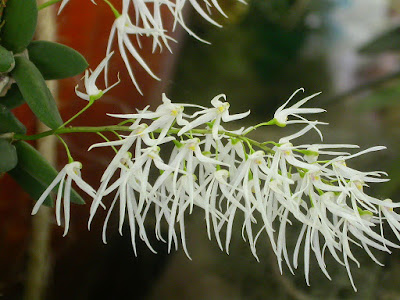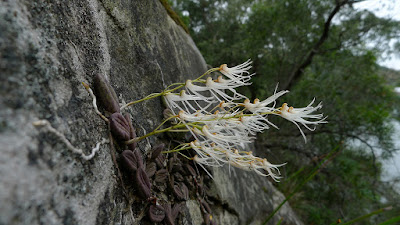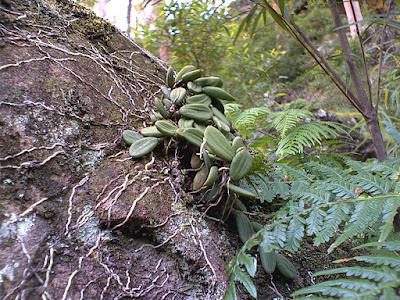Dockrillia linguiformis is native to Australia and New Caledonia, in full sun, in rare forests, or on trees in the dense shade of rainforests from sealevel to 1200 meters in elevation...
Dockrillia linguiformis also called as Tongue-Like Dockrillia, Thumbnail Orchid, Button Orchid, Tick Orchid, Callista linguiformis, Dendrobium linguaeforme, Dendrobium linguiforme, Dendrobium linguiforme var. huntianum, Dockrillia linguiforme var. huntianum, is a species of the genus Dockrillia. This species was described by Friedrich Brieger in 1981.
IDENTIFY DOCKRILLIA LINGUIFORMIS
Dockrillia linguiformis is native to Australia and New Caledonia. In Australia, the occurrence of this orchid stretches along the east coast from near Narooma in south-eastern New South Wales and north near Cooktown in Queensland. Although they usually grow close to the coast, they were found even 250 km inland, near Coolah in New South Wales. The natural habitat is extremely variable. These orchids can grow on rocks in full sun, in rare forests, or on trees in the dense shade of rainforests. The altitude of occurrence is from sea level to about 1100 m. In the more northerly locations (warmer), they are usually found in the highlands.
It is a miniature sized, cool to warm growing epiphyte or lithophyte that forms large matted clumps with a terete, 1-4 cm long stem and a creeping, branching rhizome, enveloped by sheaths and carrying sessile, alternate, ovate, oblong or obovate, very thick, smooth, 2.5-5.0 cm long, longitudinally furrowed above leaves.
Tongue-Like Dockrillia blooms in the fall and winter on an erect, to 6" (6 to 15 cm) long, 15 to 20, fragrant flowered racemes. The spider flowers are 2-3 cm long and do not open completely. They are white to cream with pink to purple spots on the lip. The lip is bent up.
DOCKRILLIA LINGUIFORMIS CARE AND CULTURE
Cultural information should only be used as a guide, and should be to be adapted to suit you. Your physical location; where you grow your plants, how much time you have to devote to their care, and many other factors, will need to be taken into account. Only then can you decide on the cultural methods that best suit you and your plants.
Light:
Dockrillia linguiformis needs a light level of 20000-40000 lux. The plants are healthier if there is a strong air movement and a full morning sun. For the rest of the day, the light should be filtered.
Temperature:
In summer, the average daytime temperature is 21 ° C, at night 12-13 ° C, which gives a daily difference of 8-9 ° C. The average temperature of the winter day is 13-15 ° C, and the night 1-2 ° C, which gives a daily difference of 12-13 ° C.
Humidity:
In summer and autumn, Tongue-Like Dockrillia needs the average humidity of 75-80%, and in winter it drops to 70%.
Substrate, growing media and repotting:
Dockrillia linguiformis grow well mounted on hardwood rootstock or cork, or attached to tree branches in the garden in areas where the climate allows you to grow outdoors throughout the year. If they are grown outside, they should be protected against strong winter precipitation.
If they grown in pots, the clay pots should be filled with loose, fast drying substrate. The plants grown in pots should be watered carefully and gently. The plants after stabilization should be moved as little as possible, therefore it is recommended to use very durable washers or substrate that does not decompose quickly. If the substrate needs to be replaced, it should be done in spring when new roots begin to grow.
Watering:
Dockrillia linguiformis should be constantly moist during active growth, but in the autumn the amount of water should be slightly reduced. The plants, however, are quite resistant to drought. And the plants that are mounted on rootstocks should be watered every evening in summer and in the morning in winter.
Fertilizer:
Weekly use of 1/4 - 1/2 dose of fertilizer for orchids is recommended. From spring to mid-summer, high-nitrogen fertilizer is preferred, and high-phosphorus should be used in late summer and autumn.
Rest period:
Dockrillia linguiformis can survive the temperatures below 0 ° C in nature, but such extreme conditions should be avoided in cultivation. However, if the plant is at very low temperatures, it is more likely to survive if it is dry then. In winter, the amount of water should be reduced, the plants should dry out between waterings, but they can not stay dry for too long. Occasional morning fogging on sunny days will be very beneficial. Fertilization should be eliminated until spring, when the amount of water increases when watering.














COMMENTS